After field-testing the PA SLx 10x42 binoculars, I speedily got to work on the Primary Arms GLx 10x42 ED binoculars to determine value considering it’s twice the price of the SLx.
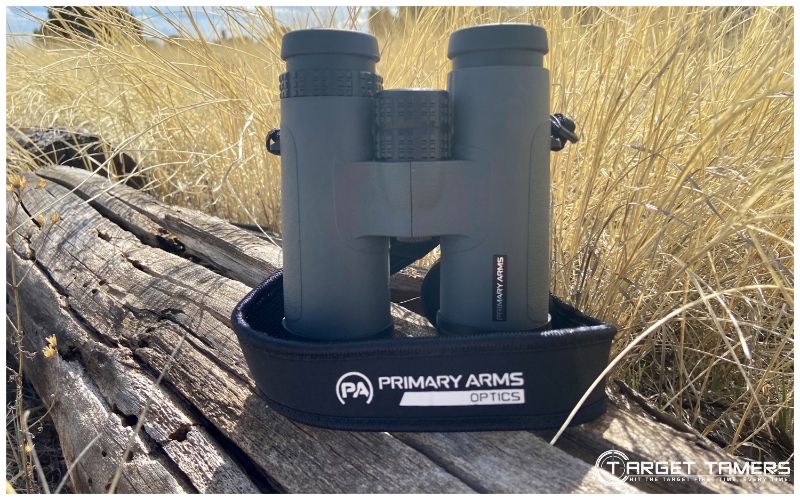
Given that the GLx has ED glass and the SLx does not, I specifically looked at focusing, resolution, optical aberrations, and recreational use from the skies to the seas.
I lay out some pros and cons of the GLx and I compare it to the SLx based on my personal hands-on field work with both.
Quick Overview...
What I Like: Optical quality
What I Don’t Like: Eye relief
Best Uses: Recreational Use, Hunting, Bird Watching, Wildlife Observation, Some Marine Use, Hiking, Sightseeing, Limited Range Use (Target Shooting)
- Magnification: 10x
- Objective Diameter: 42mm
- Coatings: FMC
- FOV: 341 ft/1000 yds
- Eye Relief: 15.2 mm
- Dimensions: 5.5x 5.5 x 2”/23.74 oz
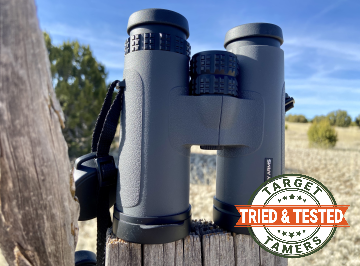
Our Verdict: Overall, the on-axis resolution and clarity provide a top-tier experience that only ED glass can provide in affordable roof prism binoculars. The Primary Arms GLx 10x42 ED are the best quality binoculars in the 10x42 configuration that I’ve field-tested at this price point.
Why Trust Me?
After hundreds of hours of hand-testing binoculars in the field and on the hunt, and thousands more hours researching, writing, photographing and creating videos about them, I feel I have earned the title of expert when it comes to optics!
Optics are not just my passion, but also my full-time job!
I get my hands on as many of the optics I test as possible (through buying, borrowing or begging!) and run them through their paces to make sure they will perform out in field.
Check out our optics testing process here.
Over a decade of experience birdwatching, wildlife observation and sightseeing has been integral in putting together this Primary Arms GLx 10x42 ED review.
Who is the Primary Arms GLx 10x42 ED Best Suited to?
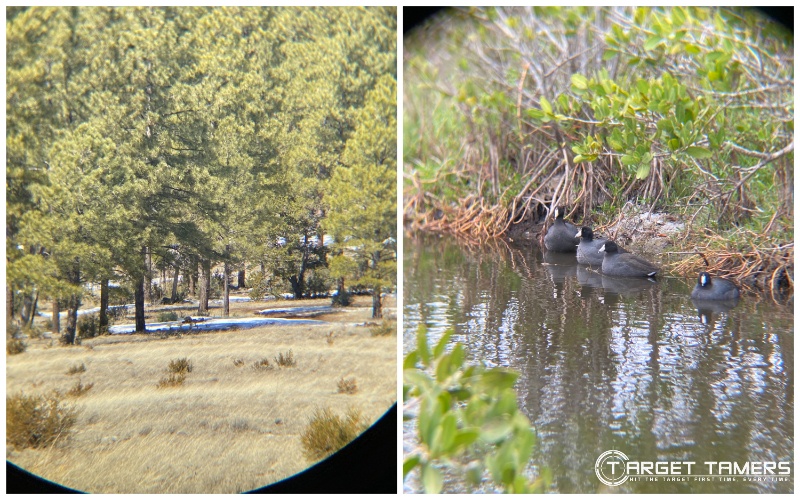
The GLx 10x42 ED are excellent, all-round binoculars that can be used in multiple applications from bird watching to hunting and some (limited) range and marine use. The low price point appeals to everyone looking for something in the mid-tier category of optics.
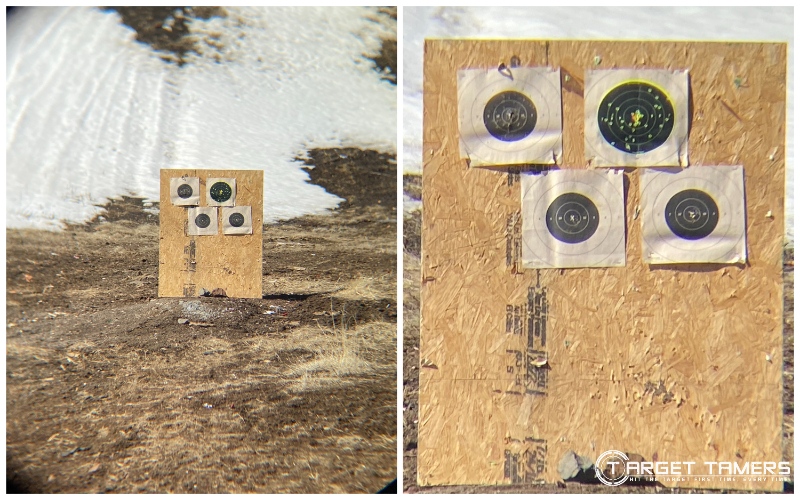
It seems to be competitive in cost and performance with the Vortex Diamondback HD and Leupold BX-2 Alpine binoculars. So, it’s right up there with the best in this price range and is an excellent option from the best binoculars under $300 market.
How Does the Primary Arms GLx 10x42 ED Perform?

Overall, the Primary Arms GLx 10x42 ED binoculars are well-made, easy to use, and glx binoculars offer staggering optical performance for the money. The optics is what sold me on the GLx binoculars, and I strongly recommend them as all-purpose binoculars for many outdoor applications.
I did a lot of handling to get a great feel for the GLx. Unrivaled image clarity is fantastic through the binoculars. However, between digiscoping and formatting these pics, a good deal of resolution is lost by the time I get them to you.

Those Anhingas sure like to pump their wings and they even posed for several shots. I also observed Great Blue Herons, Snowy Egrets, Roseate Spoonbills, and of course, curious gulls staring straight back at me.



Since I was on the shore, I had the best stability I could get, and I took advantage of my curiosity to see what was out at sea. Clarity was excellent with the inherent 10x magnification, but with more from my camera, there is resolution loss.

How do I sum up the awesomeness of the GLx?
High-performing binoculars for the cost-conscious crowd.
That’s how I describe the PA GLx ED binoculars in as few words as possible.
Features & Benefits
Optical Quality

My experience with the optics in the GLx is much like the SLx pair in that I was amazed when it came to performance for the money. Uunlike the SLx pair, the GLx has extra-low dispersion (ED) glass that made all the difference in the field.

The lens elements in the GLx brings wavelengths to a common focus point but still with some secondary spectrum chromatic aberration. It’s significantly reduced that I could not perceive it during actual field use and only became aware of it with digiscoping. Of course, digiscoping introduces inherent human error and optical issues into the process.

The depth of focus requires a more hands-on approach with the center focus knob, so most of its prowess is the on-axis clarity and sharpness that is achieved. The off-axis aberration is obviously exaggerated with digiscoping and added magnification from the camera.
With all of that, I was exceptionally pleased with what I was getting. It’s going to do the job well for bird watching, wildlife observation, and hunting.

Though it’s technically not a marine pair of binoculars, it still did well for me while on a river boat to observe a pelican rookery on the Banana River, and at the beach to observe ships, and a far-off lighthouse and bird soaring the skies near it. Though I didn’t get any pics, I also scoped out eerie boat wrecks along the Indian River.
Good for Birdwatching & Hunting

Birders and trophy hunters may get critical with a couple things about the GLx binoculars. But the Primary Arms optics GLx has excellent specs and great performance for the amateur or someone who is looking for more quality without spending the big bucks.
It has a fantastic FOV (Field of View) of 341 ft @ 1000 yards which is about competitive with both Maven and Leupold binoculars in the same configuration.

With liberal use of the focus knob, I could hone in on birds with incredible detail even to the point of identifying eye color, feather patterns, and more. I’m not a birder but I do appreciate the beauty and quirks of observing the many waterbirds I had the opportunity to see – even during feeding time which I’m sure was a delight for what I believe is a Little Blue Heron but not so much for the frog.
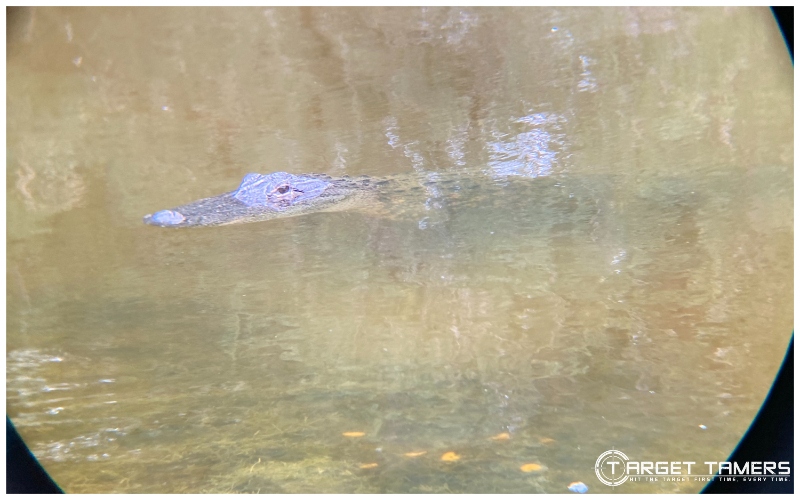
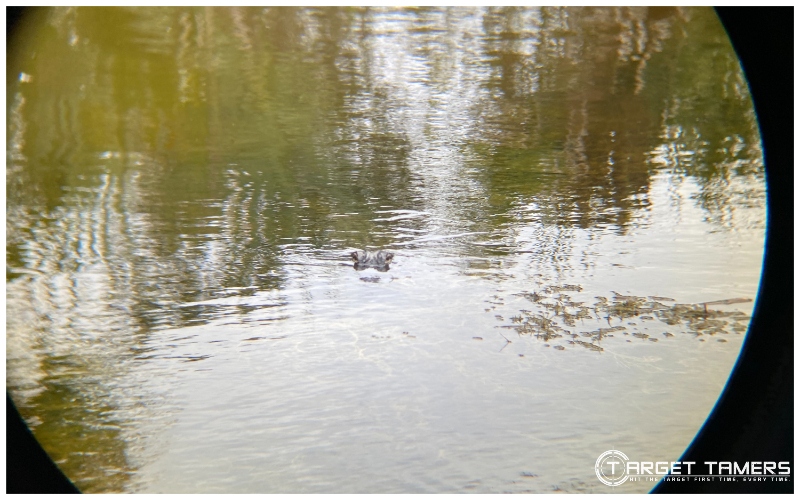
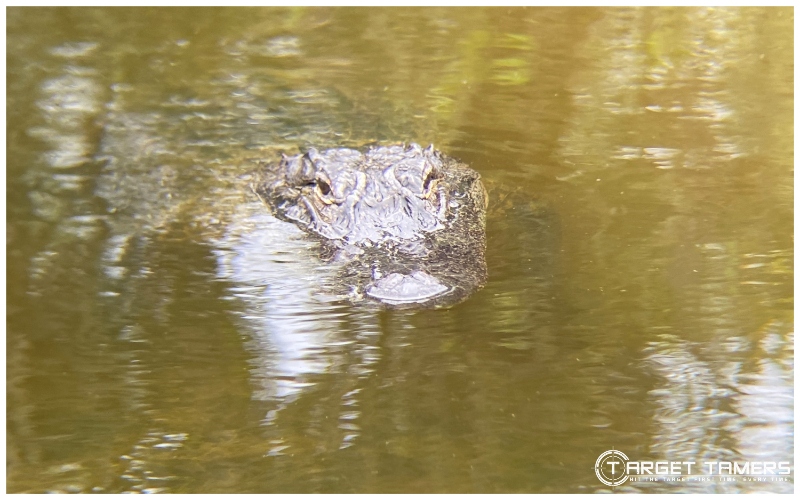
Though I’m not hunting gators, I sure did get an eyeful of a few that were in turn eyeing up me. Much like the SLx, the GLx will be great binoculars for deer and elk hunting with a boost in color fidelity and resolution with credit to the ED, just as nice glass.
Build Quality
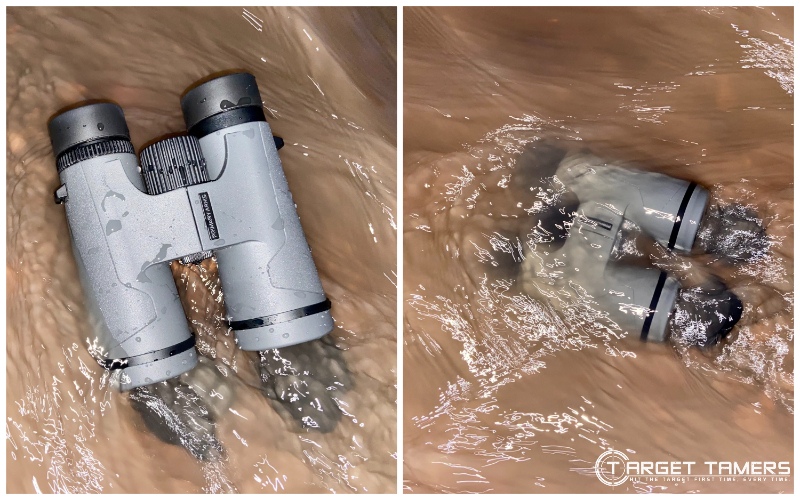
In general, after the astounding waterproof performance of the SLx binoculars, I felt no inclination to repeat it with the GLx. I have no doubt they’ll hold up to its fog and waterproof claims.
The GLx did see a lot of action on rivers and at the beach. Being exposed to water spray was not an issue for the binoculars. It did pretty amazing around sand. While the sand is easy to wipe off the rubber armor, it will get caught around the rubber objective lens tethers, eyecups, and the objective bell threading.
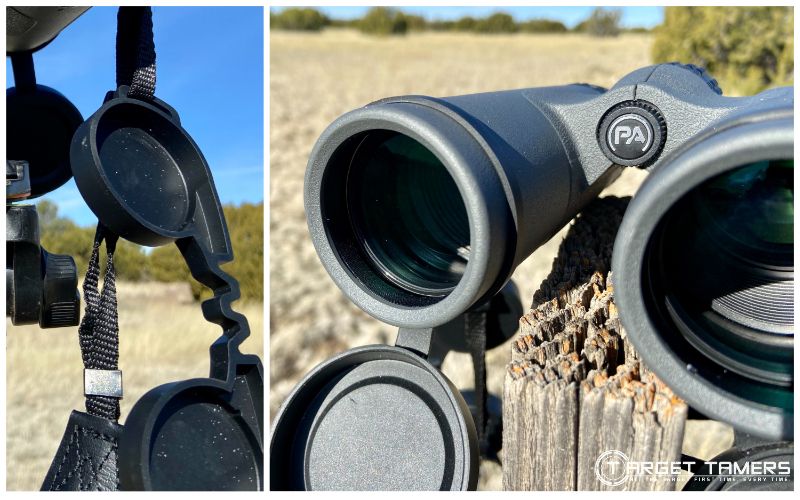
A light approach during a thorough cleaning will remove grit safely. You don’t want that sand scratching the coatings and glass or getting trapped by the eyecups and around the eyepieces.
Primary Arms says it has a magnesium chassis, but I did notice the eyecups seem to be made of the same fiber reinforced polymer construction that the SLx binoculars are made with. The eyecups have positive multi-click positions with three in total including the fully retracted position.
Portability & Handling
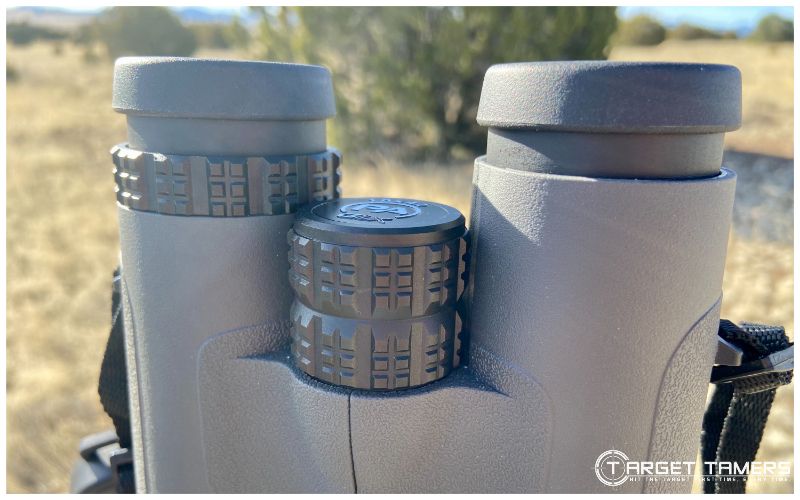
The center focus knob is what I would describe as oversized because I’m accustomed to using it with one finger. However, the size of the plastic knob on the GLx encourages two fingers for focusing that I reckon makes it easier to use.
Like its cheaper counterpart, the SLx, I had no issues tripod mounting it or using it with the included neck strap. Other than for the purpose of trying it, I only ever used the GLx as a handheld because it’s easy and convenient to do so.
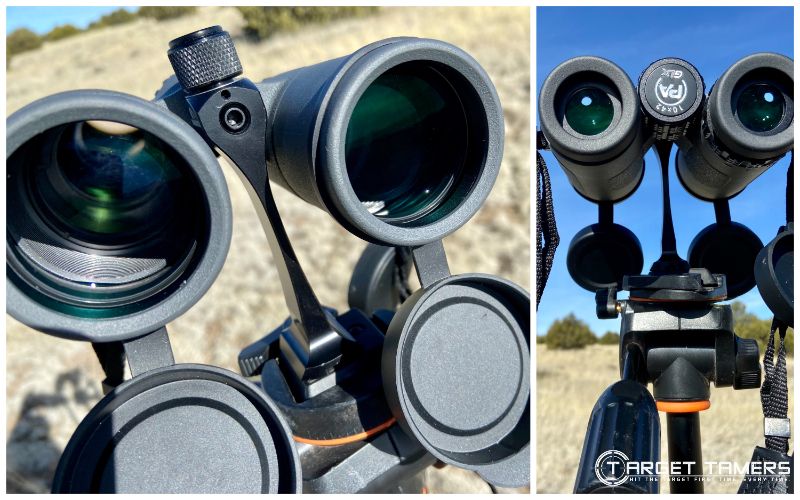
The 10x was not too much for the environment I was in. It's actually a great, all-purpose magnification and a doable power for handheld use.
I’ve seen complaints from browsers that the GLx doesn’t have a locking diopter. Honestly, I’m not worried about that. For one thing, that feature can influence cost, and secondly, the diopter has enough resistance that it’s unlikely it will move on its own. Perhaps a PLx binocular could offer this feature if there is to be a PLx bino line.
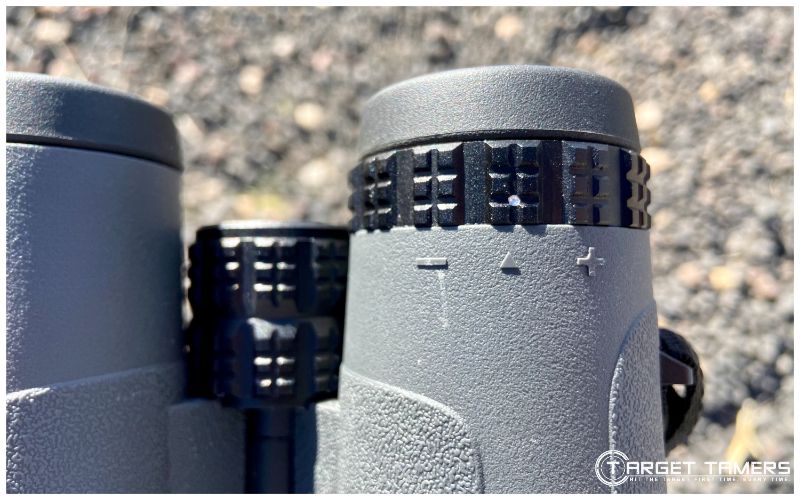
I’ve had the GLx in and out of the pouch and bouncing around in a vehicle. Other than the need to do quite a bit of focusing with the center knob, I haven’t had to mess with the diopter to justify needing a locking mechanism.
By the way, there is a silver dot for reference that you can memorize or mark on the armor where it’s supposed to be for your vision. It’s not that hard to do. For the price point and guaranteed optical performance, the lack of one is absolutely a justifiable compromise.
Primary Arms GLx VS SLx 10x42 Binoculars
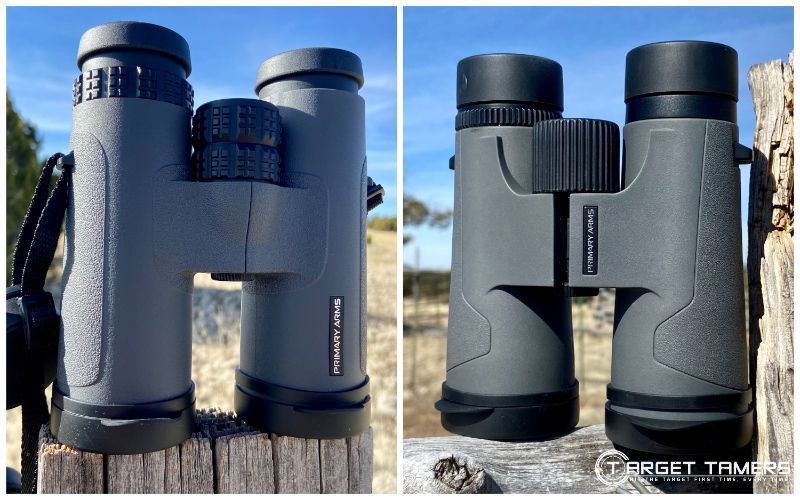
The main difference between the Primary Arms GLx and SLx binoculars is the ED glass. The optical performance is noticeable between the two with the upper hand in clarity and sharpness to the GLx model.

There are some physical differences between the moving components such as the eyecups and knurling. The GLx has a significantly larger FOV, and I would say the size and weight differences between the two are negligible. Both fall into the category of the best mid-size binoculars and are easy to handle between handheld or tripod use.



Another primary difference is cost. With the GLx priced at double the cost, it’s legitimized with the ED optics, magnesium chassis (though I really like tough polymer binos too), and wide FOV. The jump up in cost for the GLx over the SLx is worth the money.
Limitations of the Primary Arms GLx 10x42mm ED
Eye Relief for Glasses
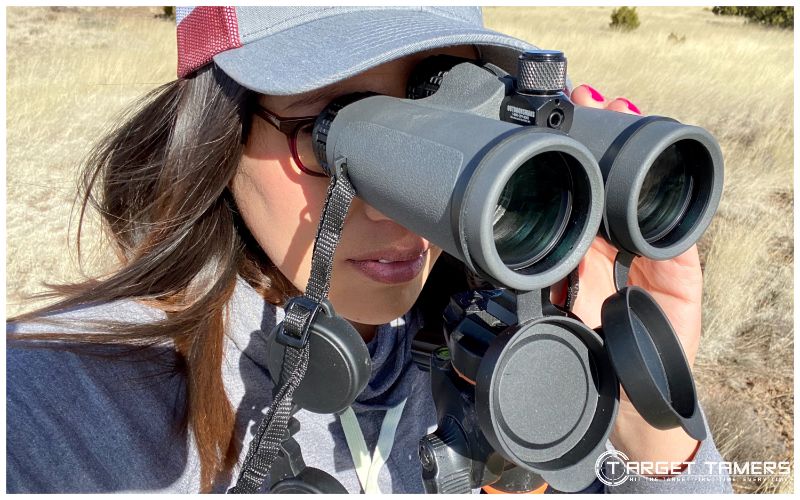
With 15.2 mm of eye relief, I was hard pressed to get comfortable with my glasses on. I did acquire sharp resolution without using the diopter with my prescription glasses, and I did get full collimation. However, I did lose a little of the FOV to vignetting.
With the frame of my glasses right up against the fully retracted rubber eyecups, it would work for quick glassing, but I wouldn’t do this for regular use.
With what I suspect as having only up to maybe -3 to +3 correction from the diopter, it won’t work for everyone. But for those who require correction less than that, you won’t need your glasses with the GLx.
Fortunately, I fit within this range, so using the diopter and ditching my glasses was my preferred method.
Popular Questions About the Primary Arms GLx 10x42mm ED
In general, Primary Arms says the difference between the PLx and GLx series is the glass. Currently, primary arms optics offers binoculars in the GLx and the SLx series. They’ve announced innovative ambitions going forward, so there may yet be more binocular offerings from Primary Arms in the near future.
GLx (left) SLx (right) - Image by Tina Fa'apoi (Own Work) for Target Tamers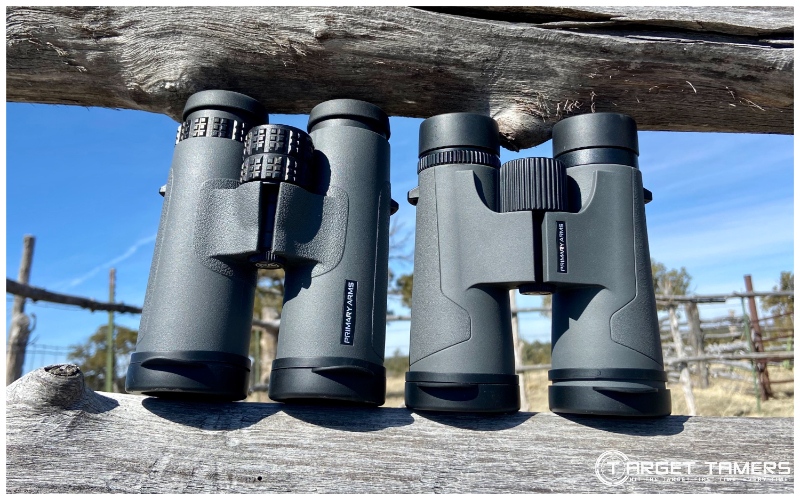
The Primary Arms GLx 10x42mm ED binoculars come with a soft carry pouch, neoprene neck strap, rubber objective lens caps, rubber rainguard, lens cloth, and manual. Each item is bagged separately into the fitted box that keeps everything tight and stationary during shipping.
What's in the GLx box? - Image by Tina Fa'apoi (Own Work) for Target Tamers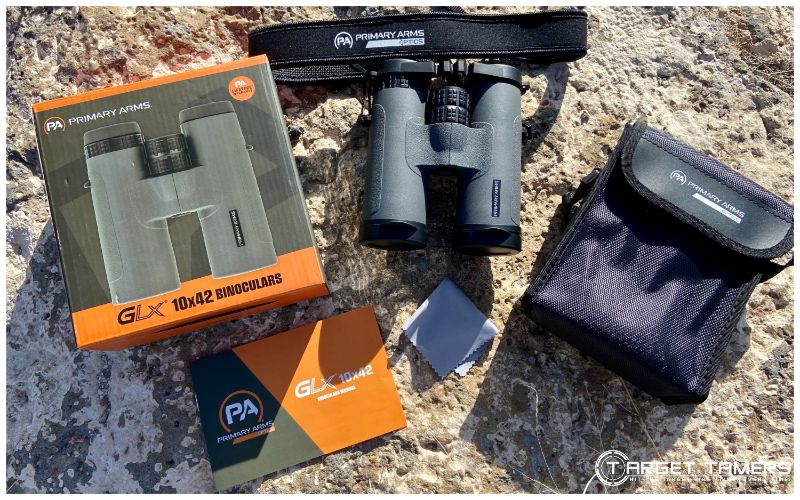
Though there is no etching or stamping on the binocular body to indicate country of manufacture, there is a sticker on the underside of the box that states Made in China. This generally indicates Primary Arms entry-level core quality.
Country of manufacture - Image by Tina Fa'apoi (Own Work) for Target Tamers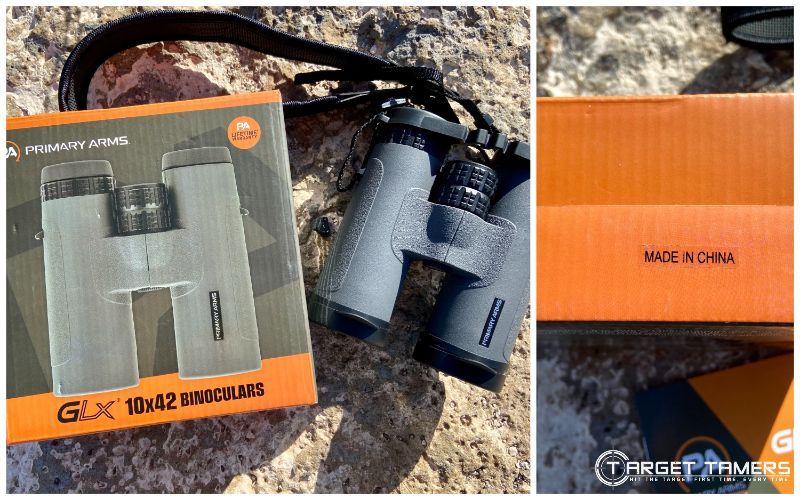
Overall, the Primary Arms GLx and SLx binoculars are waterproof. Given that the entry-level SLx binoculars are waterproof, it’s reasonable to assume Primary Arms binoculars will all be waterproof going forward.
Primary Arms SLx binocular submerged in water - Image by Tina Fa'apoi (Own Work) for Target Tamers
The GLx 10x42 ED binoculars are covered under the Primary Arms Lifetime Warranty. There are limitations and conditions, but it’s for life and is fully transferable. If a repair or replacement is not possible, Primary Arms will credit you for a purchase towards a new PA optic.
Image by Tina Fa'apoi (Own Work) for Target Tamers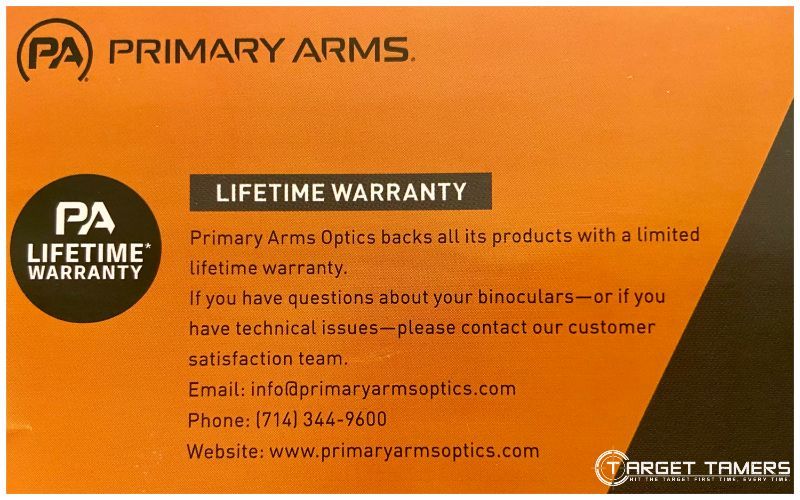
Primary Arms GLx Binoculars: Solid Midrange Value!
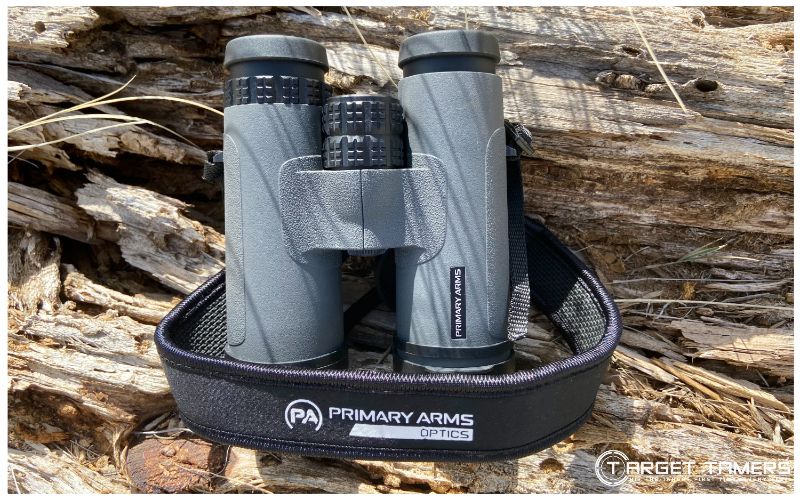
Primary Arms has nailed solid, midrange value in the GLx 10x42 ED binoculars. I think the GLx binoculars are right up there with the best in this approachable price range, and the SLx binoculars top the ranks as the best for the money.
The stunning clarity and sharpness and the lightweight build make it a convenient, go-to binocular for many applications. The performance from the GLx binos confirmed my gut feeling that these will be favorable binos among the masses for value and quality.
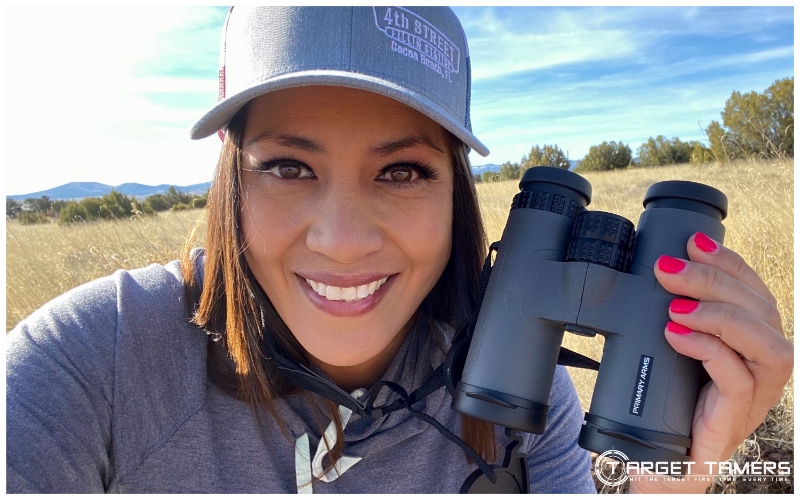
Thank you to Primary arms for sending me these binoculars to field test. Please note, even though this product was provided by the manufacturer, all my opinions expressed are my own and are not in any way influenced by any manufacturers.
Further Reading



